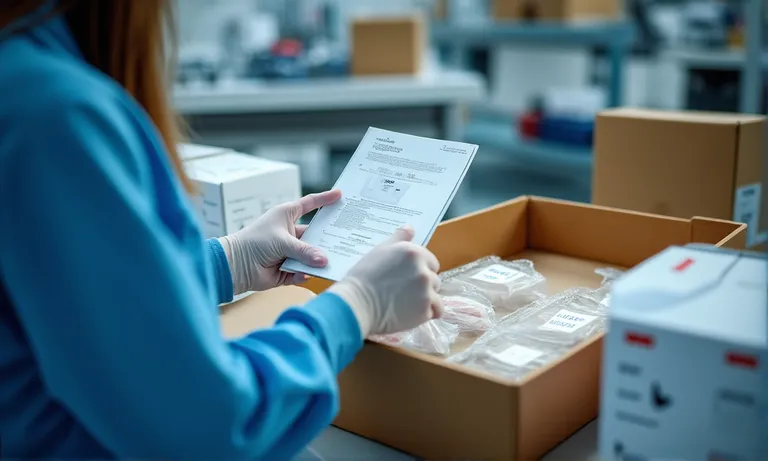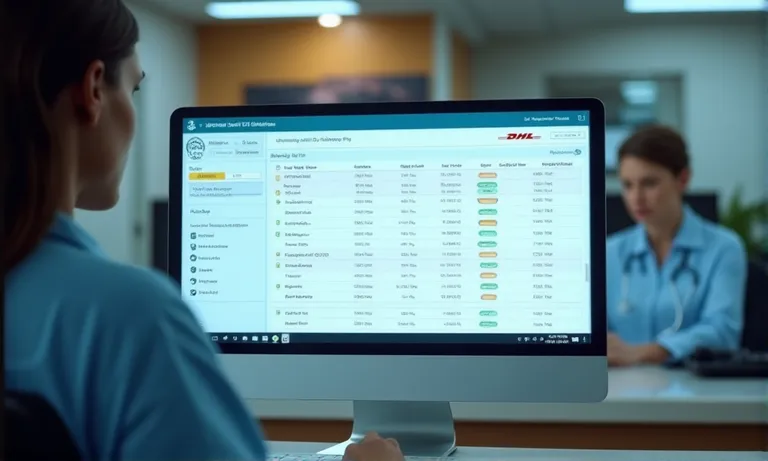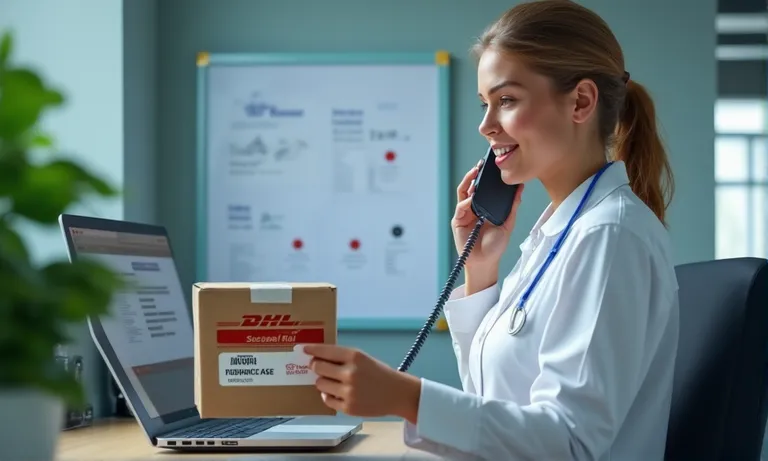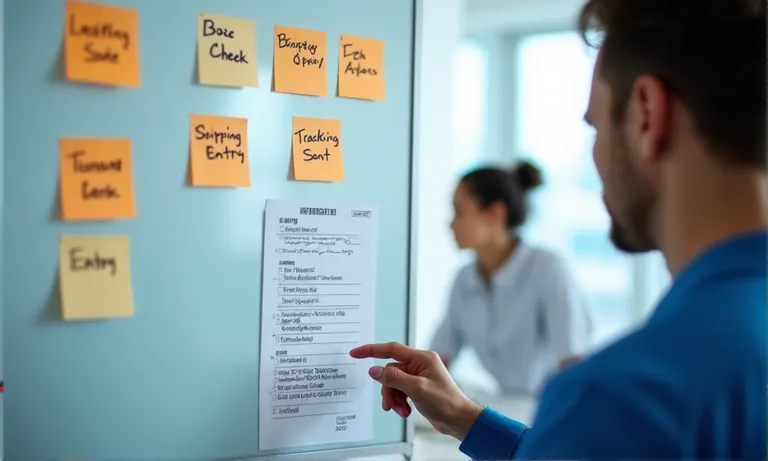Miscommunication during crown and bridge logistics isn’t just frustrating—it can lead to case delays, costly remakes, and lost trust between your clinic and lab partner. As international dental lab cooperation becomes more common, so do the risks of unclear shipment instructions, missed updates, and delayed responses across time zones.
Improving logistics communication is no longer optional—it’s foundational to achieving accuracy, timeliness, and mutual accountability. In this guide, we outline the key focus areas for clinics and procurement teams working with overseas dental labs:
- What information must be confirmed before each shipment
- Which communication channels and platforms help avoid confusion
- How to track shipments and receive real-time updates
- What to do when cases are delayed, missing, or mislabeled
- How to build a reliable, repeatable logistics workflow with your lab
By aligning expectations and standardizing communication, you minimize preventable errors, increase operational transparency, and lay the foundation for long-term, trust-based collaboration.
Why Does Logistics Communication Often Break Down in Overseas Dental Lab Cooperation?
Misaligned expectations, unclear shipment details, and inconsistent communication channels are the top reasons logistics break down between overseas dental labs and clinics. Many delays and case errors can be traced back not to technical skills—but to gaps in everyday coordination. Understanding these patterns can help clinics anticipate and avoid costly missteps.

dental-lab-logistics-communication-error
What are the most common communication gaps in crown and bridge logistics?
Crown and bridge cases are highly detail-sensitive. Yet, misalignments often start with basic assumptions:
- Incomplete case documentation: Labs receive files with missing bite scans or unclear margin lines.
- Unstandardized naming conventions: Without shared rules for labeling cases or attachments, one party may misinterpret what’s been sent.
- Inconsistent communication tools: Using multiple apps or switching between email and messaging platforms leads to lost context.
Such issues compound with volume. One misnamed STL file can delay an entire batch by a day or more.
How do these issues affect delivery time, case accuracy, or patient satisfaction?
The downstream effects of poor logistics communication are often underestimated:
| Communication Gap | Impact on Delivery | Impact on Case Accuracy | Patient Risk |
|---|---|---|---|
| Missing shipment details | Delayed customs clearance | Missed deadlines | Rescheduling appointments |
| Incorrect case ID | Wrong prosthesis fabricated | High rework rates | Reduced trust in clinic |
| No tracking updates | Clinic uncertain of status | No proactive planning | Frustration over wait time |
In one case, a U.S.-based clinic had to remake two units because the lab received reversed upper/lower arch data. The issue wasn’t technical—it was traced to a zip file labeled ambiguously: “Case_0915_NEWfinal.zip.”
Which timezone or language mismatches commonly cause delays?
Logistics often slow down not from errors—but from silence.
- Timezone gaps create “dead hours” where neither side responds for 12–16 hours.
- Language tone or ambiguity leads to hesitation—partners may wait for clarification rather than risk misunderstanding.
- Cultural assumptions (e.g., what “urgent” means) differ, causing priority mismatches.
A clinic once noted, “We thought they had ignored our message, but it was just 11:30 PM in their timezone.” With no shared response expectations, both sides grew frustrated.
Clear timezone mapping and agreed-upon response windows—like “all messages answered within 12 business hours”—can bridge this silent gap.
Consistent miscommunication doesn’t stem from a lack of effort. It stems from a lack of structure.
When both parties define expectations clearly—through naming rules, compatible formats, shared platforms, and timezone awareness—errors drop sharply. At Raytops, we’ve seen that even small habits like confirming case IDs during hand-off reduce weekly rework by up to 18%. Proactive alignment—not reactive apologies—builds long-term trust.
What Information Should Be Clearly Shared Before Each International Shipment?
Clear case documentation, consistent ID labeling, and a shared logistics checklist are essential to prevent confusion and delays in international dental lab shipments. Misalignment before shipment often creates avoidable friction, even when lab work itself is accurate. Clear communication upfront saves time, money, and trust.

dental-lab-shipment-preparation-checklist
What key details must be confirmed to avoid confusion or mismatched deliveries?
Before any shipment leaves the lab, the following information should always be aligned between clinic and lab:
- Case ID and patient initials: These must match across all files, boxes, and documentation.
- Itemized contents: Each case should list included prosthetics, materials, and special instructions.
- Bite and shade verification: Missing this leads to unnecessary remakes or post-delivery clarifications.
- Delivery address and recipient contact: Especially for cross-border couriers, clear labeling prevents customs returns.
- Shipping method and ETA: Agreement on logistics partner (e.g., DHL vs FedEx) ensures tracking consistency.
We’ve encountered cases where clients forgot to update the patient ID in their case submission, and two cases with similar initials were swapped in transit—resulting in delays and duplicate shipments. Consistency across documents avoids these mix-ups.
How should clinics and labs align on case ID, shipping content, and delivery method?
A simple 4-step alignment workflow can prevent 80% of pre-shipping issues:
- Clinic submits case form with unique ID → Ensure it’s embedded in the STL file and printed on the prescription form.
- Lab verifies item list against internal system → Confirm quantity, restoration type, and custom notes.
- Shipping staff cross-checks physical contents with form → Especially useful when multiple cases are shipped together.
- Confirmation sent before dispatch → Includes box count, courier, and expected arrival date.
This process takes less than 3 minutes per shipment—but significantly increases first-pass accuracy.
Should shared logistics checklists be implemented?
Yes—checklists are the simplest tool with the biggest impact on shipment reliability.
| Without Checklist | With Checklist |
|---|---|
| High variability in info submitted | Consistent, complete forms |
| Frequent “Did you include…?” emails | All details verified before dispatch |
| Higher chances of missing components | Reduced risk of missing items |
| More disputes over what was sent | Aligned expectations |
We recommend using digital templates or Google Sheets shared in real time. In our lab, adopting a shared logistics checklist reduced “What’s in the box?” queries by 22% within the first month.
When clinics and labs synchronize their data before shipping, everything downstream runs smoother. Even small actions—like syncing on case ID formats—create clarity across borders. As an overseas dental lab, we’ve seen the impact of small standardizations: fewer remakes, faster turnarounds, and better mutual confidence.
How Can You Ensure Real-Time Tracking and Status Updates Across Borders?
Using integrated tracking tools, shared portals, and clear communication checkpoints ensures real-time visibility across borders when working with overseas dental labs. Clinics that rely solely on courier updates often miss critical context—especially when delays occur. A multi-layered tracking approach helps both sides stay aligned and accountable.

dental-lab-cross-border-shipment-tracking-dashboard
What tracking platforms or methods are available for international lab shipments?
Tracking starts with logistics partners but shouldn’t stop there. Options include:
- Courier-based tools: DHL, FedEx, UPS all offer detailed updates, but may lack clinical context (e.g., which patient/case a box belongs to).
- Case-linked portals: Some dental labs offer online systems where cases are tagged to tracking numbers.
- Email triggers: Labs can configure automated “dispatched,” “in transit,” and “delivered” notifications tied to specific case IDs.
Relying on couriers alone creates blind spots. If a delay occurs, labs and clinics may both assume the other side is aware—only to discover it too late.
Which case management portals support real-time status updates?
Here’s a comparison of common tools clinics use to stay updated:
| Portal Type | Example | Features | Limitations |
|---|---|---|---|
| Courier Portal | DHL ProView | Live transit data, ETA | No clinical linkage |
| Lab-Clinic Portal | 3Shape Communicate | Linked to STL, order status, case ID | Requires both sides’ integration |
| Custom Lab Dashboards | Raytops Web Portal | Shipment tracking + case context | Depends on lab’s digital setup |
We’ve seen that clinics using integrated portals report 43% fewer “where is my case” messages each month.
How often should updates be shared during transport?
Timing matters as much as accuracy. A simple frequency rule can prevent confusion:
- At dispatch: Always share courier, tracking number, and case ID.
- At key checkpoints: Notify at customs clearance and arrival in the destination country.
- On delivery confirmation: Verify not just that it arrived—but who signed for it.
Clinics often cite frustration when a “delivered” status is shown, but no one on-site has received it. Timely check-ins avoid blame-shifting.
Can third-party logistics providers support communication bridges?
Yes—especially when labs and clinics are on different continents.
In some collaborations, we’ve seen third-party logistics (3PL) providers act as the communication bridge. These teams track shipments in real time, coordinate customs documentation, and proactively alert both sides if there’s an issue. While this adds cost, it often reduces last-minute surprises—particularly for DSOs managing dozens of cases weekly.
We’ve partnered with logistics coordinators in Canada and the UK who send nightly consolidated updates to our clients. For one clinic group, this shift reduced case ETA misalignment from 4.6/day to 0.8/day within one quarter.
Transparency creates accountability. By setting up layered tracking (courier + lab + shared portal), clinics gain peace of mind, and labs reduce guesswork. As an overseas dental lab, we’ve learned that shipment tracking is no longer optional—it’s a partnership baseline.
What Communication Channels and Tools Work Best with Overseas Dental Labs?
The best communication tools for overseas dental lab collaboration balance speed, structure, and traceability—often requiring more than one platform. Email alone is too slow. Chat apps lack structure. Portals are powerful but require mutual adoption. A hybrid approach, with clear rules, works best across borders.

dental-lab-multichannel-communication-dashboard
Should clinics rely on email, WhatsApp, online portals, or case management systems?
Each tool has strengths and risks:
- Email: Best for formal confirmations and document exchange, but easily buried or delayed.
- WhatsApp / WeChat: Fast and convenient for urgent updates—but difficult to track across team members.
- Online portals: Allow centralized case management, including uploads and notes—but require training and consistent use.
- Case management systems: Offer high integration, especially with digital scanners (e.g., 3Shape, Medit), but adoption varies between labs.
Most successful cross-border partnerships use a primary + secondary system. For example, portal for documentation, chat app for time-sensitive updates.
What are the pros and cons of different communication tools?
| Tool | Pros | Cons | Best Use |
|---|---|---|---|
| Formal, timestamped, searchable | Slow for urgent issues | Order forms, confirmations | |
| Fast, human | Disorganized if overused | Shipment updates, quick Q&A | |
| Portal | Integrated, structured | Onboarding needed | STL uploads, status tracking |
| Phone | Immediate clarity | Timezone conflict, no record | Escalations only |
We’ve had clients rely solely on WhatsApp. When a key technician was out sick, no one else could locate prior notes—resulting in a case delay and remanufacture.
How does timezone awareness and response time expectation affect effectiveness?
Timezone gaps create more frustration than technical issues. The key is setting shared response rules:
- “Messages will be acknowledged within X hours”
- “Case questions will be answered within 1 business day”
- “Urgent items must be flagged with red tag in subject or chat”
One Australian clinic created a timezone board listing their top five partner labs’ working hours. This simple tool helped their team send messages at better times—cutting average response lag by 40%.
How can you standardize communication without adding overhead?
Building a lightweight communication SOP is easier than it sounds. Here’s a four-step example:
- Agree on tools per topic: E.g., “Use portal for uploads, WhatsApp for shipping.”
- Define urgency flags: Clarify how to indicate critical issues.
- Assign roles: Who sends what? Who replies to what?
- Review monthly: Sync on what worked, what didn’t.
Even informal agreements make a major difference. In one Raytops-supported clinic, these steps helped eliminate internal confusion about who should follow up with the lab—and when.
Choosing the right tools matters—but aligning how you use them matters even more. As a global dental lab partner, we’ve seen that structured communication is not about adding work—it’s about reducing avoidable chaos.
How Should You Handle Shipping Exceptions, Delays, or Missing Items?
The key to managing shipping exceptions is fast, clear, and blame-free communication—supported by predefined escalation paths. Delays or missing cases aren’t always avoidable, but confusion and frustration can be. Clinics and labs that agree on a shared response rhythm resolve issues faster and protect long-term trust.

dental-lab-shipment-error-resolution-call
What immediate information should be shared when something goes wrong?
When a shipment is late, incomplete, or incorrect, both sides need clarity fast. Here’s what clinics should immediately provide:
- Case ID: Always start with the unique identifier to avoid guesswork.
- Issue type: Delay, missing item, damaged prosthetic, wrong case?
- Proof of receipt: Images of packaging, box label, and contents.
- Requested action: Clarify if this is informational, a remake request, or an urgent fix.
From our experience, when clinics skip this structure and only say “It’s wrong,” it often takes 24+ hours to fully understand the issue. A checklist-style message solves this in minutes.
What templates or escalation paths help resolve issues quickly?
An effective escalation path helps small problems stay small. Here’s a typical 3-layered approach:
- Frontline Contact (0–6 hours)
- Clinic sends issue details to lab’s daily coordinator
- Lab acknowledges within defined time window (e.g., 6 business hours)
- Mid-Level Resolution (6–24 hours)
- If urgent or unresolved, escalate to QC lead or logistics manager
- Decision made on remake, credit, or express resend
- Management Escalation (>24 hours)
- Used when delay impacts multiple cases or financial resolution is needed
- Involves lab director or client success manager
We’ve used this path for high-volume partners and saw issue resolution time cut by 63% over two months.
How can both sides avoid blame-shifting and focus on resolution?
The most efficient partnerships treat errors as shared issues, not accusations. Clinics and labs can adopt three mindset principles:
- Assume positive intent: Start with solving, not blaming.
- Use facts, not feelings: Stick to timestamps, files, and images.
- Define “what happens next” quickly: Who’s remaking? Who’s reshipping? What’s the adjusted ETA?
One of our DSO clients said it best: “The most helpful labs aren’t perfect—but they respond before we even ask.”
As an overseas dental lab, we believe it’s not about avoiding every mistake—it’s about building a system that handles mistakes fast, fairly, and openly.
How Can You Build a More Efficient, Repeatable Logistics Workflow with Your Lab Partner?
Establishing a shared logistics SOP (standard operating procedure) with your dental lab partner is the fastest path to fewer delays, better tracking, and smoother communication. A good workflow doesn’t rely on memory or goodwill—it’s designed, documented, and refined over time. Efficiency is a system, not a hope.

dental-lab-logistics-sop-review-whiteboard
What elements should be included in a lab-clinic logistics SOP?
A practical logistics SOP doesn’t need to be complex—but it must be complete. At a minimum, include:
- Case Intake Protocols: File formats, labeling conventions, who reviews incoming data
- Shipping Confirmation: Courier choice, tracking method, dispatch notification
- Issue Escalation Flow: What happens when cases are delayed, incomplete, or misrouted
- Communication Channels: Preferred tools by topic (e.g., WhatsApp for urgent, portal for uploads)
- Turnaround Time Benchmarks: Agreed expectations for case types, with buffers
In our experience, labs that help clients co-create this SOP build faster trust and reduce back-and-forth.
How can regular reviews or case summaries improve long-term collaboration?
Scheduled reviews—monthly or quarterly—turn “accidental collaboration” into intentional partnership. Benefits include:
- Spotting recurring errors: Missed shades, repeated file format issues
- Adjusting timelines: Based on evolving clinic needs (e.g., adding chair time buffers)
- Highlighting success metrics: On-time delivery rates, reduced remake count
One of our clients in New Zealand sends a bi-weekly “case exceptions summary,” listing what went wrong (if anything) and why. This transparent loop helps both sides adjust and improve—together.
How should feedback be tracked and used to reduce future miscommunication?
Tracking feedback doesn’t require fancy software. Here’s a simple before-and-after snapshot of what structured feedback can do:
| Before SOP | After SOP (8 weeks in) |
|---|---|
| Avg. response delay: 18h | Avg. response delay: 5h |
| Repeated case ID issues | Standardized labeling adopted |
| 3–5 remake discussions/month | Reduced to <1/month |
| No trend visibility | Monthly case trend summary shared |
At Raytops, we’ve supported clinics by co-developing SOPs based on real shipment data. One DSO partner reduced back-and-forth messages by 14% simply by agreeing to a shared checklist + weekly sync call.
Repeatability = scalability. When a clinic and lab build repeatable workflows together, they don’t just reduce errors—they increase margin for growth. As a global dental lab partner, we know that long-term logistics success isn’t built on promises, but on process.
Conclusion
Working with an overseas dental lab doesn’t need to feel uncertain. When communication is structured, expectations are shared, and logistics are standardized, cross-border cooperation becomes not only possible—but scalable. From aligning on case IDs to managing real-time tracking and handling delays with clarity, efficient collaboration is built on process, not luck.
As an overseas dental lab, we’ve seen that trust grows fastest when both sides operate within a transparent, repeatable framework. Whether you’re managing ten cases a week or a hundred, the right communication and workflow systems make the difference between friction and flow.


